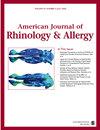This Summer, Think Like a Vagabond.
IF 2.5
3区 医学
Q1 OTORHINOLARYNGOLOGY
引用次数: 0
Abstract
I am excited and honored to introduce the July 2023 issue of the American Journal of Rhinology and Allergy. As this issue finds its way to your desk, those of us in the northern hemisphere are enjoying the throes of summer. For many of us, summer brings warm temperatures, time off for longawaited vacations, and fuller homes as students take a break from school or college. Many of us in medicine more specifically recall July as a time of transition, when newly graduated residents take their first step into independent practice, fellows arrive in our institutions to hone their craft, and freshly minted interns take a stab (literally) at learning what it truly means to be a physician. For me, summer brings memories of growing up in Michigan, the birthplace of the American automotive industry, where I spent my summers playing, working, or taking the occasional road trip. When I was asked to introduce this summer edition of AJRA, an illustrative piece of Midwestern lore came to mind which, to me, mirrors the quest for innovation shared by our authors and readers alike. In the early 20th century, a few friends embarked on a series of legendary summer road trips across the United States. Between 1915 and 1924, their adventures took them from vast expanses of Great Lakes coastline to the Florida Everglades and many places in between. As they camped across the country, they found that they shared a penchant for innovation, and the trips became catalysts for remarkable conversations and fresh ideas which influenced their work upon returning home. One of these “fresh ideas” was to call themselves the Vagabonds. Today, the Vagabonds are better known to us as Thomas Edison, Harvey Firestone, and Henry Ford. The Vagabonds embodied the spirit of progress as they blended Edison’s inventive mind, Ford’s revolutionary approach to manufacturing, and Firestone’s tire expertise to leave an indelible mark on the automotive industry while road tripping down America’s first byways. The story of the Vagabonds serves as a reminder of the profound impact that friendship, enduring bonds, and collective ambition can have on inspiring progress. In the same way, the AJRA community’s pursuit of progress is driven by an inherent curiosity and a desire to improve patients’ lives. The impact of technology on our field cannot be overstated, and in this issue of AJRA we present several articles in which technological innovation is highlighted. Artificial intelligence (AI) represents one of the most highly publicized and discussed topics not just in rhinology, but across all fields. Since the introduction of natural language models such as ChatGPT at the end of 2022, AI has entered the public consciousness so rapidly and universally that it represents one of the most important themes of this year. In this issue, Osie et al examine AI in the field of rhinology in their timely scoping review. Their manuscript examines the current literature and highlights opportunities for future investigation in AI as this technology makes its way from a topic of public discourse into the fabric of our daily lives. Tang et al describe the use of a new intraoperative navigation system equipped with a virtual reality (VR) feature to perform balloon sinus dilation of the maxillary sinus. In their cadaveric study, they present pilot data which supports the use of VR features to improve the accuracy of identifying and cannulating the natural ostium of the maxillary sinus. Cryoablation of the posterior nasal nerve to treat chronic rhinitis became more available in 2017 following the introduction of the Clarifix device which offered an alternative to more traditional surgical treatments such as vidian neurectomy. Young et al present a systematic review and metaanalysis examine the efficacy of cryoablation for chronic rhinitis and suggest that their findings indicate that it is an effective treatment modality for the ailment. This month’s issue contains several articles which leverage our evolving knowledge of sinonasal anatomy to enhance surgical treatments for sinusitis and skull base pathology. Wong et al examine a robust collection of patients who underwent endoscopic modified medial maxillectomy and reveal that many of these patients experience an improvement in symptoms based on SNOT-22 scores, and more importantly, most of these patients did not Editorial这个夏天,像个流浪汉一样思考。
本文章由计算机程序翻译,如有差异,请以英文原文为准。
求助全文
约1分钟内获得全文
求助全文
来源期刊
CiteScore
5.60
自引率
11.50%
发文量
82
审稿时长
4-8 weeks
期刊介绍:
The American Journal of Rhinology & Allergy is a peer-reviewed, scientific publication committed to expanding knowledge and publishing the best clinical and basic research within the fields of Rhinology & Allergy. Its focus is to publish information which contributes to improved quality of care for patients with nasal and sinus disorders. Its primary readership consists of otolaryngologists, allergists, and plastic surgeons. Published material includes peer-reviewed original research, clinical trials, and review articles.

 求助内容:
求助内容: 应助结果提醒方式:
应助结果提醒方式:


